NIF Status Update – 2014
January
NIF’s Neutron Yield Continues to Climb; Alpha Heating Yield Exceeds 50 Percent
The NIF/Weapons and Complex Integration (WCI) collaboration conducted a high-energy, high-neutron-yield experiment on Jan. 20-21 to test the layered deuterium-tritium (DT) implosion performance of a high-foot (high initial laser pulse) ignition design using a gold-lined depleted uranium hohlraum. All 192 NIF beams delivered 1.85 megajoules of 3ω (ultraviolet) energy, with a peak power of 414 terawatts.
The shot produced another record primary neutron yield of 7.9 × 1015 (7.9 quadrillion) and a total yield, including downscattered neutrons, of 9.6 × 1015, or 27 kilojoules (kJ) of fusion energy—an increase of about 10 kJ over the previous high-foot experiment. More than half of the yield (14.5 kJ) was attributed to alpha heating—the process in which the alpha particles (helium nuclei) created by the fusion reactions in the implosion “hot spot” are absorbed by and further heat the assembled fuel, enhancing the yield.
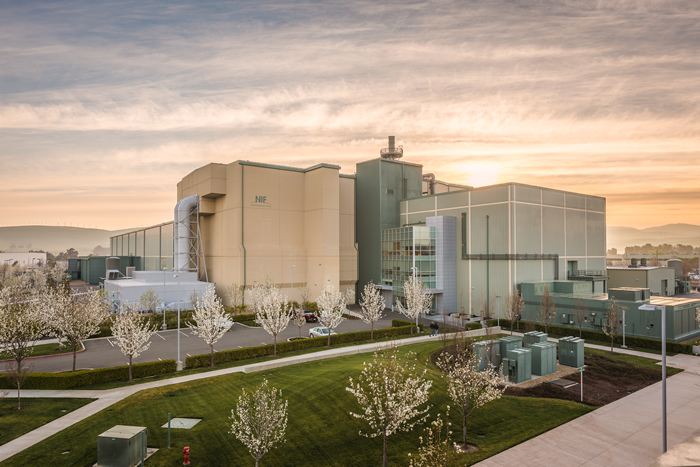
Use of the depleted uranium hohlraum resulted in a notably more symmetric hot spot; and as in the previous high-foot experiments, there was no sign of ablator mixing into the hot spot, indicating that hydrodynamic instabilities remain at bay.
Remaining shots in this sequence using the current capsule will further test predictions of laser power scaling and initial ice layer conditions. The campaign also is exploring thinner capsules as a means to achieve higher implosion velocities, to further test the hydrodynamic instabilities, and to determine where mix starts to quench the implosion.
“This new record yield for our facility is progressing us toward the much-needed high energy density burning plasma platform for the Stockpile Stewardship Program,” said Acting NIF&PS Principal Associate Director Jeff Wisoff. “Congratulations to all the teams who contributed to this most recent success.”
NIF Facility Maintenance & Reconfiguration Period Successfully Completed
The NIF Facility Maintenance & Reconfiguration (FM&R) Period that began on Dec. 21 was successfully completed on Jan. 14. Among the major tasks completed during the period were installation and testing of release 13.5 of the Integrated Computer and Control System; upgrade of the shroud arms on the target positioner; installation of a new streaked polar instrumentation for diagnosing energetic radiation (SPIDER II) and a gated x-ray detector (GXD-G); and installation of triple-pulse plasma electrode Pockels cell (PEPC) pulse generators for the Advanced Radiological Capability (ARC) (see photos).  (Above) Pulsed Power Systems Engineer Glen James takes measurements in the Bldg. 391 plasma electrode Pockels cell (PEPC) lab on a circuit board used in the solid-state switch pulse generators (pulsers) for NIF’s Advanced Radiological Capability (ARC). This is one of 54 similar circuits combined to produce the 16.5-kilovolt switch pulse required to rotate the polarization of the light in the ARC PEPC. It uses a MOSFET semiconductor device to switch the high-voltage output on and off at the high rate needed for ARC’s unique triple pulse. (Below) PEPC Technician Tony Runtal completes a test on two of the ARC pulsers in the PEPC lab. The pulsers (on the left) provide the 16.5-kilovolt switch pulses to the PEPC in a three-pulse burst. See below for more information on ARC’s progress.
(Above) Pulsed Power Systems Engineer Glen James takes measurements in the Bldg. 391 plasma electrode Pockels cell (PEPC) lab on a circuit board used in the solid-state switch pulse generators (pulsers) for NIF’s Advanced Radiological Capability (ARC). This is one of 54 similar circuits combined to produce the 16.5-kilovolt switch pulse required to rotate the polarization of the light in the ARC PEPC. It uses a MOSFET semiconductor device to switch the high-voltage output on and off at the high rate needed for ARC’s unique triple pulse. (Below) PEPC Technician Tony Runtal completes a test on two of the ARC pulsers in the PEPC lab. The pulsers (on the left) provide the 16.5-kilovolt switch pulses to the PEPC in a three-pulse burst. See below for more information on ARC’s progress. 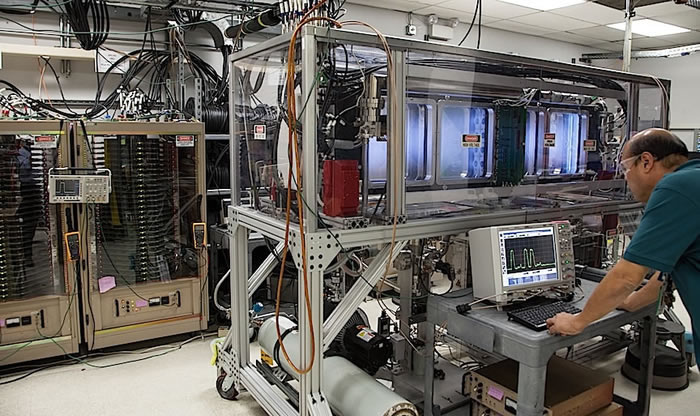
January Experimental Highlights
NIF experiments resumed on Jan. 16; here are some highlights of the month:
- The first three-shock keyhole shock-timing experiment using a copper-lined hohlraum was conducted. The copper liner is intended to reduce preheating of the fusion fuel, which can interfere with ignition, without doping the plastic capsule with other material such as silicon. Good target diagnostic data were obtained, including Velocity Interferometer System for Any Reflector (VISAR) shock timing data.
- On Jan. 17, the NIF Team conducted the third shot in the Los Alamos National Laboratory high energy density shock/shear campaign to evaluate interacting shock waves created by two halfraums (half hohlraums) on opposite sides of a shock tube. The objective was to take high-quality radiography data with the hardened gated x-ray detector (hGXD) on two detector strips at mid-time in the shock tube.
- A high energy density material strength system experiment was conducted on Jan. 23-24. The experimental and alignment teams were able to significantly simplify the target and beam alignment sequence for this experiment, saving several hours in the shot-cycle time for this platform. Additional improvements have been proposed.
- The team completed the second high-foot (high initial laser pulse), three-pulse shock tuning shot with a thin-shell (175-micron) capsule on Jan. 25. A standard-length (9.43-mm) hohlraum with a small laser entrance hole was used. Shock timing data from the previous high-foot thin-shell shot on Dec. 20 showed asymmetric first shock breakout. The shock timing shot was in preparation for the next thin-shell layered deuterium-tritium (DT) implosion experiment scheduled for February. Good VISAR data were obtained.
- On Jan. 27, the team conducted the next shot in the hydrodynamic growth radiography (HGR) campaign. The shot measured Rayleigh-Taylor instability growth of a preformed ripple (240-micron spatial frequency and 1.5-micron amplitude) in the capsule during implosion under a high-foot drive. The ripples were backlit with an iron backlighter target and imaged with Gated X-ray Detector GXD3; good data were acquired.
- The team conducted the next high-density carbon (diamond) capsule shock-timing experiment on Jan. 30-31, using a larger (6.72-millimeter-diameter) hohlraum to reduce the effects of plasma filling. Excellent data were acquired; preliminary analysis indicates that the target has high absorption similar to other near-vacuum hohlraums and almost no fast-electron preheat.
- A Jan. 31-Feb. 1 hydrodynamic growth radiography experiment measured Rayleigh-Taylor instability growth of pre-imposed ripples on the surface of the target capsule during a low-foot (low initial laser pulse) drive. The ripples were imaged with Gated X-ray Detector GXD3 with a scandium backlighter; good data were obtained.
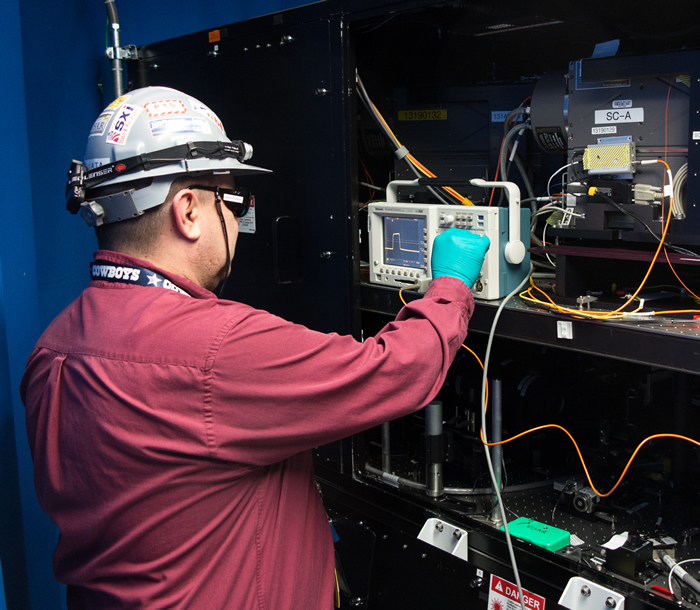 Controls technician Paul Zapata troubleshoots a VISAR camera trigger.
Controls technician Paul Zapata troubleshoots a VISAR camera trigger.  Cryogenic Operations’ Russell Spain installs a fresh bottle of deuterium in the Target Positioner gas manifold for the Jan. 25 shock timing shot.
Cryogenic Operations’ Russell Spain installs a fresh bottle of deuterium in the Target Positioner gas manifold for the Jan. 25 shock timing shot. 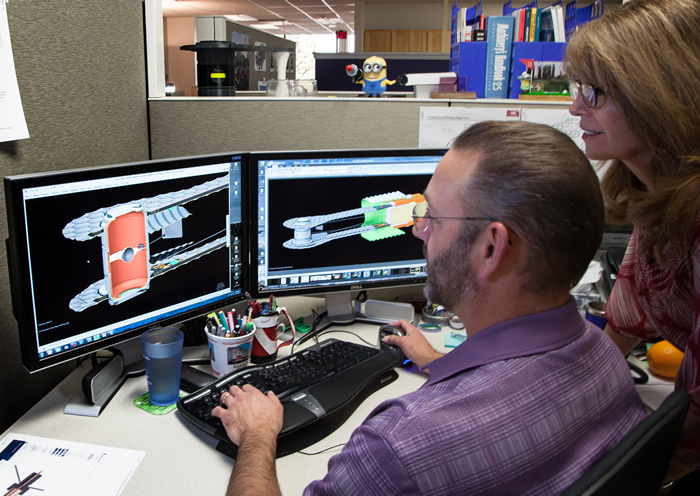 Target design manager Carolyn Vargas and designer Scott Vonhof review the design of the new 6.72-millimeter-diameter hohlraum.
Target design manager Carolyn Vargas and designer Scott Vonhof review the design of the new 6.72-millimeter-diameter hohlraum. NIF’s Petawatt Laser System Continues to Make Good Progress
Work to complete the first four beamlets (two split NIF beam apertures) on the Advanced Radiographic Capability is progressing steadily. ARC is a petawatt-class laser with a peak power exceeding one quadrillion (1015) watts and is designed to produce brighter, more penetrating, higher-energy x rays than is possible with conventional radiographic techniques.
The ARC Team recently began a series of laser shots to the calorimeters at the exit of the NIF laser bay using a subset of the ARC systems, including the ARC Injection Laser System (ILS). This system consists of the ARC master oscillator, dual regenerative amplifiers for the A and B beamlets, and the split-beam injection (SBI) system.
The laser shots are being performed in parallel with the installation and alignment of the ARC compressor and parabola vessel components in the Target Bay and the ARC short-pulse diagnostics in the Target Bay and switchyard. The goals of these shots are to:
- Optimize the beamlet spatial profiles and the temporal stretched pulse shape at the main laser output by adjusting ILS components
- Ramp up the energy in a safe manner from 200 joules to 1.8 kJ per beamlet for a pulse that could be compressed to 30 picoseconds (trillionths of a second)
- Optimize the laser performance models for broadband laser amplification, which are used to set up and analyze ARC shots
- Provide training opportunities for shot operations personnel on ARC shots using the recently developed Integrated Computer Control System automated ARC shot controls
- Demonstrate and if required, improve ARC ILS reliability and stability by routinely operating these systems in system shots.
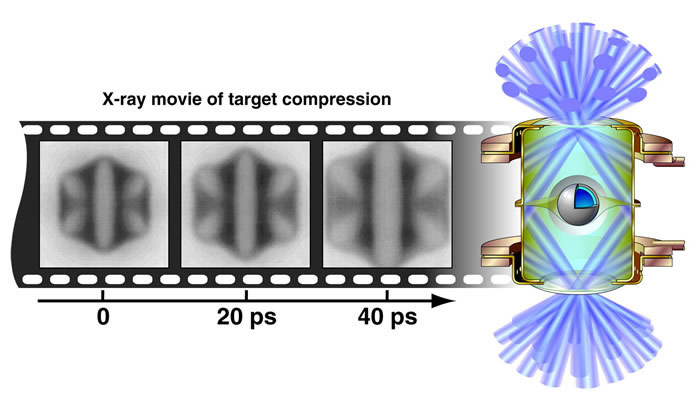 ARC splits each of four NIF beams (one quad) into two apertures, producing up to eight petawatt-class laser pulses that can be used to create high-energy x-ray images of the target.
ARC splits each of four NIF beams (one quad) into two apertures, producing up to eight petawatt-class laser pulses that can be used to create high-energy x-ray images of the target. Significant progress also has been made on the ARC hardware being installed in the Target Bay and switchyard:
- Installation of utilities (cabling, piping, ventilation, platforms, cleanrooms), optical components inside the argon beampath, and the compressor diagnostic beampath and diagnostic table are complete
- The first eight compressor gratings are installed in the vacuum compressor chamber
- Test fit of the optical line-replaceable unit (LRU) frames in the parabola vacuum vessel using specialized transport and handling equipment is complete.
The remaining ARC hardware is scheduled for installation by the end of April, after which integrated commissioning to the ARC compressor diagnostics and to Target Chamber center can begin.
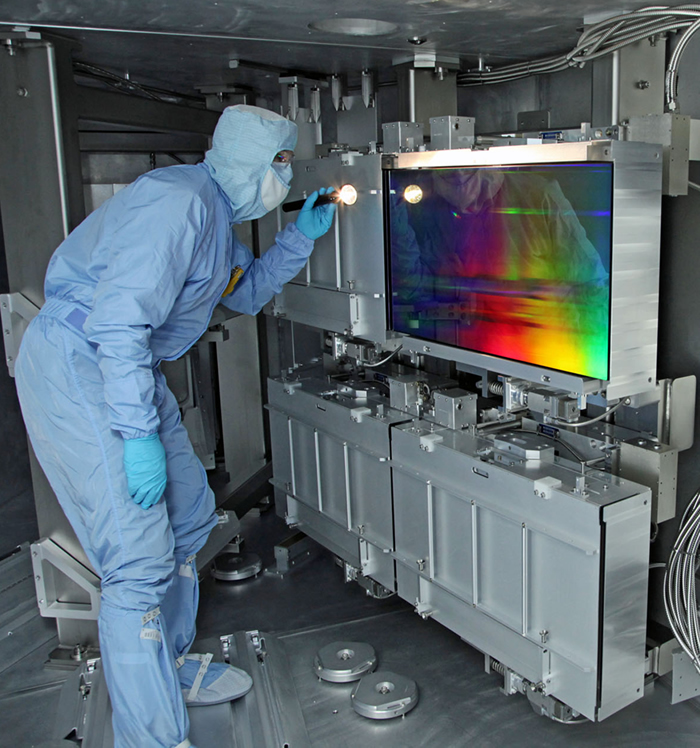 Engineer JB McLeod inspects one of the first four high-efficiency diffraction gratings installed in the ARC compressor vessels. ARC’s one-meter-wide multilayer dielectric gratings were specially developed at LLNL to withstand the record levels of energy generated by NIF’s lasers. ARC’s high peak power is enabled by a process called chirped-pulse amplification, in which a short, broadband pulse is first stretched in time to reduce its peak intensity, then amplified at intensities below the damage threshold in the laser amplifiers, and finally compressed to a short pulse and highest peak power in the large compressor vessels.
Engineer JB McLeod inspects one of the first four high-efficiency diffraction gratings installed in the ARC compressor vessels. ARC’s one-meter-wide multilayer dielectric gratings were specially developed at LLNL to withstand the record levels of energy generated by NIF’s lasers. ARC’s high peak power is enabled by a process called chirped-pulse amplification, in which a short, broadband pulse is first stretched in time to reduce its peak intensity, then amplified at intensities below the damage threshold in the laser amplifiers, and finally compressed to a short pulse and highest peak power in the large compressor vessels. 



